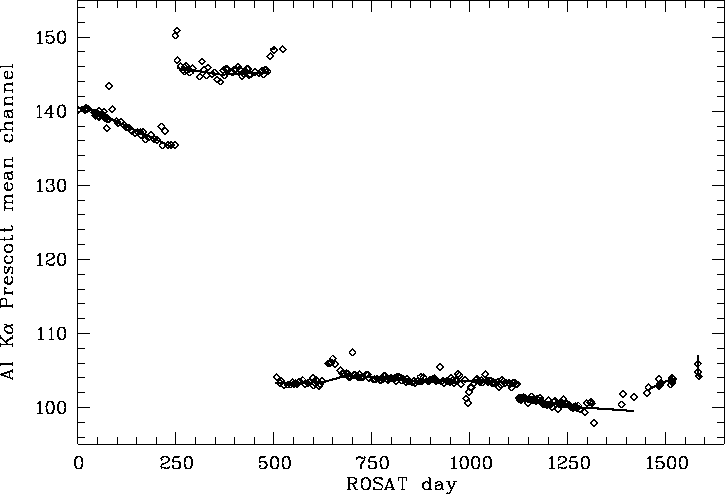| About ROSAT |
ROSAT Home Page | ROSAT Images |
|---|
The measured pulse height ![]() of an X-ray photon depends on
the gain which can be determined with an on-board calibration source.
The Al K
of an X-ray photon depends on
the gain which can be determined with an on-board calibration source.
The Al K ![]() line at 1.487keV should peak at the
pulse height invariant PI channel 151.
The actual bin BAL of the mean of the Al K
line at 1.487keV should peak at the
pulse height invariant PI channel 151.
The actual bin BAL of the mean of the Al K ![]() line is
obtained from fitting a Prescott function to the distribution of
the measured amplitude
line is
obtained from fitting a Prescott function to the distribution of
the measured amplitude ![]() of the Al K
of the Al K ![]() line
and assigned to
line
and assigned to ![]() .
Prescott functions follow the relation
[Prescott1963, Hink
et al.1970]
.
Prescott functions follow the relation
[Prescott1963, Hink
et al.1970]
![]()
where the variable x represents any convenient measure of the pulse height and the parameters N and a determine the shape of the function. The peak of the distribution can be computed from its derivative
![]()
which yields

Figure F.1 gives an overview over the gain history of PSPC-C and PSPC-B. In the following sections three typical values of BAL will be used:
SASS uses a table with 106 elements of TIME and BAL stored in the steering database of the INGRES management system. For any given photon arrival time SASS determines the corresponding BAL by linear interpolation (solid line in Fig. F.1) while the open diamonds denote all available calibration data (some have been excluded from SASS usage due to housekeeping information etc., [Briel1996]).

Figure F.1: The bin of the Al K ![]() line (BAL) as a
function of time: during the main part of the
survey (i.e., ROSAT days < 242)
PSPC was in focus, with almost linearly decreasing gain.
Then PSPC-B was operated at slightly higher gain until the
high voltage was reduced from 3060 V to 3000 V (ROSAT day 502),
which resulted in a drop of the gain.
Finally, the gas flow rate was reduced (ROSAT day 1121) to extend
the PSPC lifetime.
Dots denote values averaged over all calibration
measurements of a relevant ROSAT day.
The line segments show an average value used by SASS:
as within one orbit gain variations of
line (BAL) as a
function of time: during the main part of the
survey (i.e., ROSAT days < 242)
PSPC was in focus, with almost linearly decreasing gain.
Then PSPC-B was operated at slightly higher gain until the
high voltage was reduced from 3060 V to 3000 V (ROSAT day 502),
which resulted in a drop of the gain.
Finally, the gas flow rate was reduced (ROSAT day 1121) to extend
the PSPC lifetime.
Dots denote values averaged over all calibration
measurements of a relevant ROSAT day.
The line segments show an average value used by SASS:
as within one orbit gain variations of ![]() 1%
(i.e., more than one channel) were found it is advised to use a
(long-term) mean value rather than the daily average value.
The mean values were provided by
[Briel1996]
1%
(i.e., more than one channel) were found it is advised to use a
(long-term) mean value rather than the daily average value.
The mean values were provided by
[Briel1996]